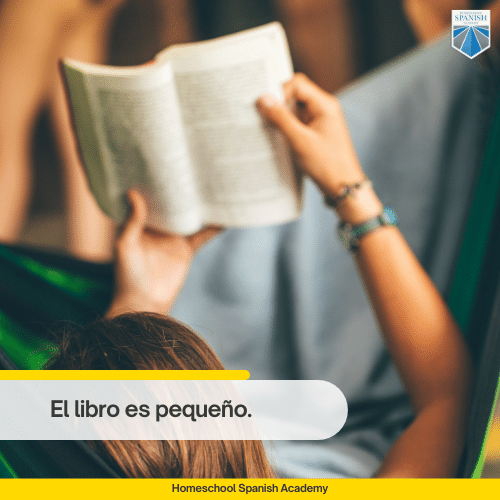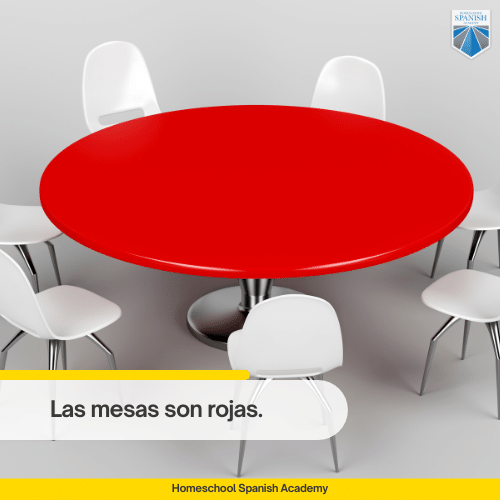Notifications
ALL BUSINESS
COMIDA
DIRECTORIES
ENTERTAINMENT
FINER THINGS
HEALTH
MARKETPLACE
MEMBER's ONLY
MONEY MATTER$
MOTIVATIONAL
NEWS & WEATHER
TECHNOLOGIA
TV NETWORKS
VIDEOS
VOTE USA 2026/2028
INVESTOR RELATIONS
COMING 2026 / 2027
ALL BUSINESS
COMIDA
DIRECTORIES
ENTERTAINMENT
FINER THINGS
HEALTH
MARKETPLACE
MEMBER's ONLY
MONEY MATTER$
MOTIVATIONAL
NEWS & WEATHER
TECHNOLOGIA
TV NETWORKS
VIDEOS
VOTE USA 2026/2028
INVESTOR RELATIONS
COMING 2026 / 2027
About Me
 Latinos Media
Latinos Media Latinos Media provides all types of news feeds on a daily basis to our Members
Posted by - Latinos Media -
on - August 17, 2023 -
Filed in - Noticias -
-
1.1K Views - 0 Comments - 0 Likes - 0 Reviews

Spanish adjectives are one of the main pieces of the Spanish language puzzle.
If you figure out how to use them, you’ll be one step closer to achieving your language fluency goal.
But why are adjectives so important in Spanish? And more, how should you use them?
Do they work in the same way as in English?
Keep reading to learn the answers to these and other questions, and discover some of the most essential grammar rules about Spanish adjectives.
Let’s dive into 50 of the most common and useful Spanish adjectives distributed by category, including translation and examples.
Join 559 million people on the planet who speak Spanish!
Sign up for your free trial Spanish class today. 

Various reasons explain why adjectives in Spanish have such a significant role in the language’s grammar.
Let’s start with the most basic one: adjectives “are one of the 9 parts of speech.”
This means that adjectives are one of the fundamental parts of the Spanish language. Without them, you couldn’t communicate your ideas properly.
Spanish adjectives are nothing but Spanish description words, which means you will use them to express how someone or something is, looks, or behaves.
Also, Spanish adjectives are “ spelled one way in singular and differently in plural.”
In practice, this situation means that you need to understand how Spanish adjectives work and master their use to achieve fluency in the language.
How to Use Adjectives Correctly in SpanishYou can use Spanish adjectives to “modify, quantify, describe, or identify a Spanish noun.”
However, Spanish adjectives work in a slightly different way than English adjectives. Let’s learn a little bit more about how to use them.
Grammar Rules for the Use of Spanish Adjectives Rule #1: Spanish Adjectives Have to Match the Gender of the NounDo you remember that every noun in Spanish has a gender? We aren’t talking about niño or “boy” and niña or “girl” kind of gender. Those are easy and pretty obvious.
Instead, we are talking about how a mesa or “table” is a feminine noun and a libro or “book” is a masculine one.
Well, once you know the gender of your noun, you have to adapt your adjective to match it.
Example:La mesa es roja.
The table is red.
See how the table isn’t rojo which is the name of the color red in Spanish, but roja because it matches the feminine gender of mesa.
El libro es pequeño.
The book is small.
In this case, the masculine noun libro matches the masculine adjective pequeño (if it were a feminine noun would have to be pequeña).

The same thing as with gender, Spanish adjectives need to match the number of the noun. By number, in this case, we mean singular or plural.
Example:La mesa es roja.
The table is red.
Using the same example from the previous grammar rule, you can see that mesa is singular, so roja is also singular.
Las mesas son rojas.
The tables are red.
As you can see, just by changing the number of the noun to the plural form, as in mesas, the adjective also has to match that number and, for that reason, becomes rojas.

Notice how the adjective isn’t the only part of the sentence that is modified. The article and verb also change to match the number of the noun.
Rule #3: Spanish Adjectives Usually Come After the NounThis is a very flexible rule, but I think it’s useful for new learners that want to grasp the basic structure of the language.
While in English, adjectives come before the noun, in Spanish, adjectives usually come after the noun in the sentence. “Usually” is the keyword.
Example:La casa grande.
The big house.
However, some adjectives, such as numerical ones, are commonly found before nouns.
Example:La tercera República.
The third Republic.
Also, other adjectives can come before the noun in the sentence if you want to emphasize your adjective or give it a poetic tone.
However, remember that there are more common ways to write or speak Spanish.
Example:El feroz guerrero.
The fierce warrior.
Finally, some Spanish adjectives change meaning depending on whether they come before or after the noun.
Needless to say, you have to consider the adjective’s position in your sentences.
Example:Esa es mi antigua casa.
That’s my previous house.
Ella vive en una casa antigua.
She lives in an old house.
In the first sentence, antigua means “previous,” a house where that person used to live before. While in the second sentence, antigua translates as “old.”
List of Useful Spanish AdjectivesOnce we have learned the importance of Spanish adjectives and how to use them, let’s get to know some of the most useful and common ones!
Spanish Adjectives to Describe a Person PhysicallyThese adjectives are words to describe someone in Spanish from a physical perspective.
| Spanish | English |
| guapo, guapa | handsome, good looking |
| feo, fea | ugly |
| alto, alta | tall |
| bajo, baja | short |
| joven | young |
| viejo | old |
| delgado, delgada | thin |
| gordo, gorda | fat |
| rubio, rubia | blond |
| pelirrojo, pelirroja | redhead |
El novio de María es muy guapo.
Maria’s boyfriend is very handsome.
Tu hermana es muy alta.
Your sister is very tall.
Esa chica pelirroja es mi prima.
That redhead girl is my cousin.
Spanish Adjectives to Describe PersonalityWhen describing a person, you can talk about their physical appearance or personality.
The following list include the Spanish adjectives most commonly used to describe personality.
| Spanish | English |
| amable | kind |
| interesante | interesting |
| simpático, simpática | friendly |
| divertido, divertida | funny |
| agradable | pleasant |
| aburrido, aburrida | boring |
| alegre | cheerful |
| egoísta | selfish |
| valiente | brave |
| tímido, tímida | shy |
Carlos es un chico muy alegre.
Carlos is a very cheerful boy.
Mónica es un poco tímida.
Mónica is a little bit shy.
Tu amiga es muy interesante.
Your friend is very interesting.
Spanish Adjectives to Describe a PlaceThe following list includes Spanish adjectives commonly used to describe a place, from a house to a city or country.
| Spanish | English |
| moderno, moderna | modern |
| tranquilo, tranquila | calm |
| grande | big |
| pequeño, pequeña | small, little |
| bonito, bonita | nice |
| acogedor, acogedora | cozy |
| pintoresco | picturesque |
| lujoso, lujosa | luxurious |
| fascinante | fascinating |
| ruidoso, ruidosa | noisy |
Londres es una ciudad muy moderna.
London is a very modern city.
Mi barrio es pequeño y tranquilo.
My neighborhood is small and calm.
Machu Pichu es un lugar fascinante.
Machu Pichu is a fascinating place.
Spanish Adjectives to Describe a ThingNow is the turn to explore a few Spanish adjectives that can help you to describe a thing.
| Spanish | English |
| antiguo, antigua | old |
| nuevo, nueva | new |
| largo, larga | long |
| caro, cara | expensive |
| barato, barata | cheap |
| suave | soft |
| duro, dura | hard |
| brillante | bright, shiny |
| pesado, pesada | heavy |
| ligero, ligera | light |
¿Te gusta mi coche nuevo?
Do you like my new car?
Esa camisa se ve muy cara.
That shirt looks very expensive.
Mi bicicleta es muy ligera.
My bike is very light.
Spanish Adjectives That Start With AFinally, let’s learn about some Spanish adjectives that start with the letter “A.” As you’ll discover that there are many of them, and they’re some of the most used ones.
In this list, you won’t find the adjectives that start with “A” already mentioned in previous lists.
| Spanish | English |
| absurdo, absurda | absurd |
| ambicioso, ambiciosa | ambitious |
| ansioso, ansiosa | anxious |
| amarillo, amarilla | yellow |
| azul | blue |
| amargo, amarga | bitter |
| ácido, ácida | sour |
| asustado, asustada | scared |
| agresivo, agresiva | agressive |
| apacible | peaceful |
Esta película es absurda.
This film is absurd.
Estoy un poco ansioso por el examen de Matemáticas.
I’m a little anxious about the Math test.
Este chocolate sabe muy amargo.
This chocolate tastes very bitter.
A Few Tips on How to Use Adjectives in a ConversationFirst, when you discover a Spanish adjective that ends in the letter “e” or a consonant, you don’t have to worry about the gender of the noun.
In these cases, the adjective won’t change its form. Agradable will always be agradable (not agradabla), and azul will always be azul (not azula).
However, in those same cases, the number does matter.
When you have an adjective ending in “e,” and you want to change it to plural, all you have to do is add an “s” at the end, like in agradables.
On the other hand, if you want to modify a Spanish adjective that ends in a consonant to a plural, you need to add the ending “-es,” like in azules.
To avoid confusion or other issues, always place your adjective after the noun.
That’s the safest bet, and you’ll avoid double guessing yourself and keep the conversation more fluid.
Practice Your Spanish Adjectives and Improve Your Fluency Today!As discussed throughout this article, Spanish adjectives play a crucial role in the structure and functioning of the Spanish language.
Learning them and mastering their use is a stepping stone in your path to achieve fluency.
Sign up today for a free trial class with one of our certified, native Spanish-speaker teachers from Guatemala.
They offer flexible scheduling and student-tailored Spanish programs. Moreover, you can practice your Spanish adjectives and speak Spanish from your very first class.


“This is the best way for your kid to learn Spanish. It’s one-on-one, taught by native Spanish speakers, and uses a curriculum.”
– Sharon K, Parent of 3

“It’s a great way to learn Spanish, from native Spanish speakers in a 1-on-1 environment. It’s been fairly easy to schedule classes around my daughter’s other classes. The best value for us has been ordering multiple classes at a time. All the instructors have been great!”
– Cindy D, Parent of 3

“HSA offers very affordable, quality, one on one classes with a native speaker. My son has greatly benefited from taking classes. We have seen his confidence increase as well as his pronunciation improve because he learns from a native Spanish speaker. HSA has quick, personal customer service. Our family has been very pleased with our experience so far!”
– Erica P. Parent of 1
The post Spanish Adjectives To Describe Everything You Need appeared first on Homeschool Spanish Academy.